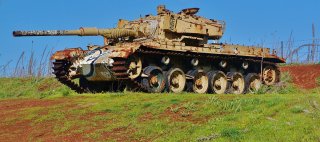In 1973, the Yom Kippur War Gave the World a Horrifying Glimpse of What a Modern Mechanized Warfare Would Look Like
The Yom Kippur war resulted in the death of 2,500 to 2,700 Israelis and an estimated ten to 16,000 Arab soldiers—and wounded over twice that number. The IDF lost roughly a thousand tanks destroyed or temporarily knocked out and 102 jets, while Arab forces lost 2,400 armored vehicles and over 400 hundred jets.
Israeli commando units using captured amphibious tanks slipped across the Suez and began destroying artillery and anti-aircraft batteries along the west bank. Weathering constant artillery fire, Israeli engineers hastily built two pontoon bridges over which Israeli armored units followed, throwing the Egyptian rear line into chaos. Again, the collapse of the air defense system allowed Israeli airpower to come into full effect.
By then, Arab nations were pressuring the Western world through an oil embargo. Washington and Moscow were actively resupplying the opposing sides—and inching dangerously close to war. Both superpowers convened in the UN and hastily imposed a ceasefire on October 22. Minutes before it came into effect, Soviet technicians unleashed three Egyptian Scud missiles on Israeli positions, killing seven—the weapon’s first operational test.
The ceasefire almost immediately broke down, and the IDF resumed its advance, threatening Cairo and leaving the Egyptian 3rd Army trapped on the eastern side of the canal. Aware of the army’s precarious situation due to intel from Blackbird spy planes, Henry Kissinger pressured Golda Meir into agreeing to a second ceasefire in a bid to salvage Egyptian pride and secure Cairo’s future good will. This second ceasefire on October 25 stuck despite a flurry of initial violations.
By then, the IDF had advanced within 25 miles of Damascus and was bombarding it with M107 self-propelled artillery. The ceasefire narrowly averted a planned all-out Syrian counter-attack using newly imported Soviet tanks, though sporadic fighting would continue in Golan through 1974.
The Yom Kippur war resulted in the death of 2,500 to 2,700 Israelis and an estimated ten to 16,000 Arab soldiers—and wounded over twice that number. The IDF lost roughly 1,000 tanks destroyed or temporarily knocked out and 102 jets, while Arab forces lost 2,400 armored vehicles and over 400 hundred aircraft. The IDF would later recover 400 knocked-out T-55 and T-62 tanks for IDF service.
At the time, the Yom Kippur war highlighted how long-range anti-tank and anti-aircraft missiles would reshape modern battlefields, proving that tank and aviation units needed to adapt to new tactics and technology. The extraordinary pace at which the conflict consumed men and material would be even greater today in an era of longer-range missiles, more powerful networked sensors and far more precision-guided weapons. However, the war also showed that tactical prowess and sound operational leadership could result in lopsided loss-ratios between forces of similar technical capability.
Despite its losses, Egypt emerged from the conflict energized by the sentiment that its honor had been restored by the initial recapture of the Suez canal. Five years later, Sadat would effectively bring an end to three decades of bloody Egyptian-Israeli conflicts with the Camp David Accords—which handed a demilitarized canal zone back to Egypt and cemented long-lasting ties between Cairo and Washington. Tel Aviv and Damascus, however, never reconciled and remain locked in proxy conflicts to this day.
Sébastien Roblin holds a Master’s Degree in Conflict Resolution from Georgetown University and served as a university instructor for the Peace Corps in China. He has also worked in education, editing, and refugee resettlement in France and the United States. He currently writes on security and military history for War Is Boring.
Image: Wikimedia


